Thesis - Prototyping with Etsy in Mind
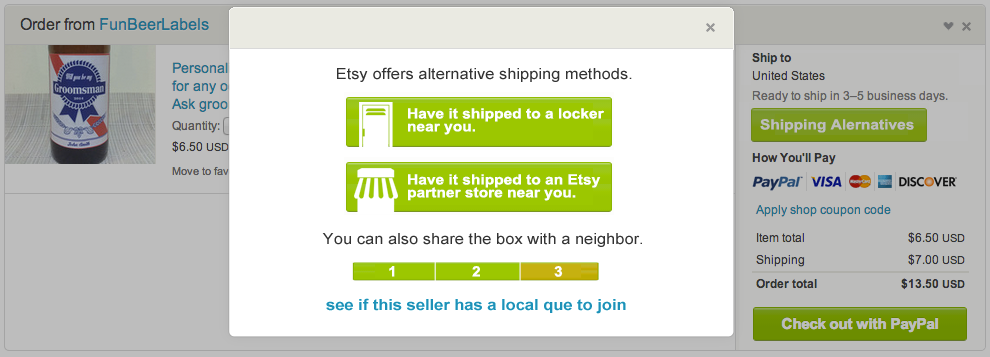
The unexpected consequence of the online marketplace has been the influx of shipping and the inherent cost. Amazon mis-calculation of its Prime memberships the first year they offered the service lead to a loss of 9 cents of every dollar in revenue. (USA Today)
Etsy, as a platform has a escalating interest in focusing on shipping as a sustainability effort. And being a a B-Corp — wherein the status requires them to be accountable to the mission as much as they are accountable to their stakeholders bottomline. Etsys is then evaluated on criteria centered around offsetting our emissions and creating more value for users in these sustainability practices.
It is rare in corporate America to have a large business with a platform of change at its core. Etsy has over 30 million transactions a month with over 20 millions items listed to some 60 million unique visitors. Also the community involved is enormous. The platform is progressive and ready for introductions of service design interventions around shipping and Co2 relief in general.
I have outlined some solutions below after spending an afternoon with two leading designers and thinkers at Etsy headquarters in Brooklyn. Matt Stinchcolb, the VP of Values and Impact and Cap Watkins, the Product Design Lead (also of the team that is focused on shipping solutions.) Matt’s passion is to make sure Etsy is fulfilling it’s B-Corp mission. Cap is focused on leading a team thinking about solutions and the day to day design management of Etsy’s site components. Cap also previously worked on shipping solutions for Amazon.com.
The two of them gave me many ideas and quotes as I talked with them. I’ve taken the quotes and ideas and made some general previews of what these types of interactions might look like on the Etsy site and some offline to.
Shipping Carbon Score
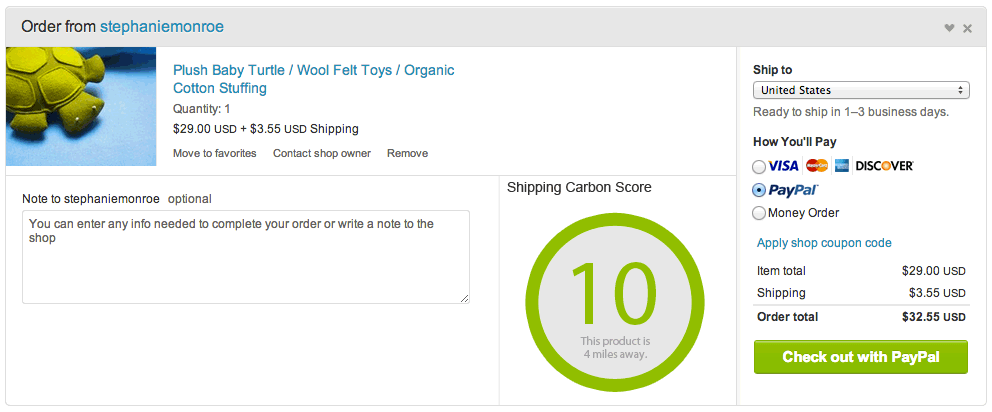
The first concept is simply an indication of a carbon score on the checkout page. Measuring from 1-10, bad to good. Based on how far a product would have to be shipped and how that might be shipped. Matt stated that anything traveling over 400 miles is most likely going to catch a ride on a plane, and as we know planes are some of largest emissions polluters.
This idea has a core flaw: which is that it would mostly detract users from following through with the purchase, or, in other words, hang them up at the most important gateway page — no online store wants to impede efficiency at the point of sale.
My advisors feedback was that this could be useful as a modal. Say if there were a slider that the user could move from 1-10 that would change the shipping options as it moved. Very much making it more of a fun engagement than something that makes a customer feel guilty about buying something they truly admire and want.
Source Map Integration
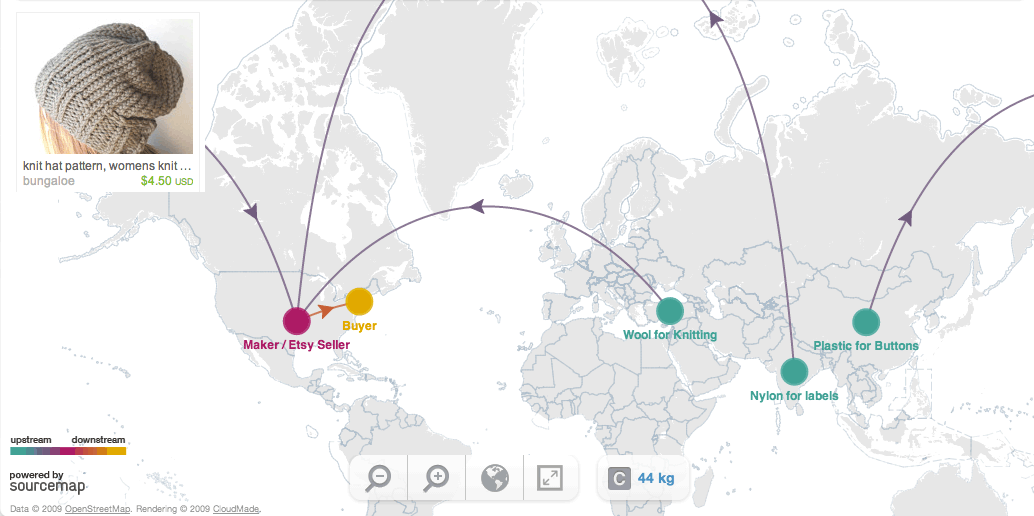
There is a great webapp called SourceMap where anyone can go and set up a map of their supply chain. This proposal is to build a prototype where the seller can share their SourceMap supply chain transparently with the Etsy community. SourceMap automatically does loose calculations of the carbon cost of the type of material, the distance it will have to travel, and the type of travel.
There is already an initiative at Etsy that’s working with sellers to provide complete transparency in where they get their materials, the processes they use, and even the staffing of their operations. Since most sellers are individuals or small shops this is pretty simple and upfront information. But, as the product scales, more and more sellers are actual multi-employee shops and having details about their businesses rolls back into the Etsy B-Corp mission.
Shop Local Edit
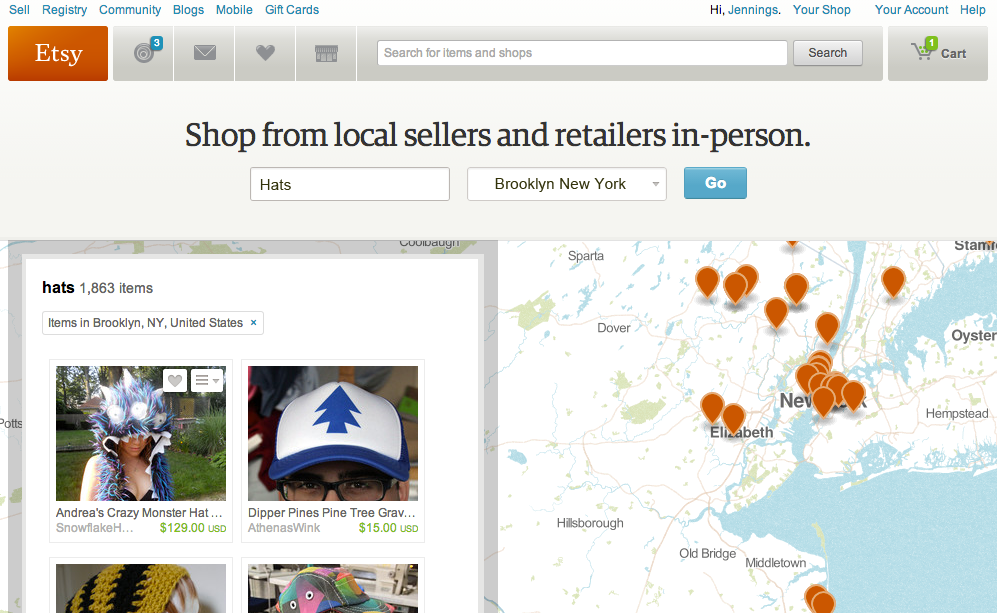
Etsy has a shop local prototype that anyone can use. Find it here. It allows you to search out your location, then provides you with a list of events that local Etsy sellers frequent. When I searched for my address in New York it brought up the Brooklyn Flea (which is near my house), but the listing only had a few vendors. This is a new prototype and it’s only in beta so hopefully as sellers discover this it will make its way to the Etsy main drag.
The image above outlines this in a different way where the product search function is available. In this case I searched for hats and was able to see the products that I could buy locally. This could also be a navigation element that gives a foresight of the kinds of products you might find around your location.
Shipping Alternatives
The following concepts focus solely on the shipping platform of Etsy. The end user is the buyer in most cases.

Lockers
The locker concept is a good one and has been semi-successful in bigger urban areas but it is limited by that. Also, it does little or nothing to reduce carbon cost since the product is still being shipped to the locker. And if the buyer has to take two trips to get the order out of the locker, one could argue that it cost up to two times more carbon emissions.
Partner Stores
Partner stores are an excellent example where the frameworks for building them already exist. It would simply take the wholesale platform for stores like West Elm and allow customers to pick up the product there. Though this still has the same issues as the lockers which is that it neither reduces cost from seller to store and again could add cost with the buyer making a round trip.
Sharing The Box
This concept is a little out there and pretty much a desperate attempt at a shipping method that would have a real world application yet help reverse the shipping emissions cost. The idea is that the buyer would enter a queue and once the cue was fulfilled near them the package would be sent. Etsy informs all the buyers where and to whom the package is being sent. The buyer who receives the package works with the other buyers to help them get their product. Lastly, the buyer can set a duration of time before the shared shipping would be dismissed and the product would be shipped in the traditional method of their choice after that time has elapsed.
Here is a diagram I made to assist in explaining the Shared Box interaction:
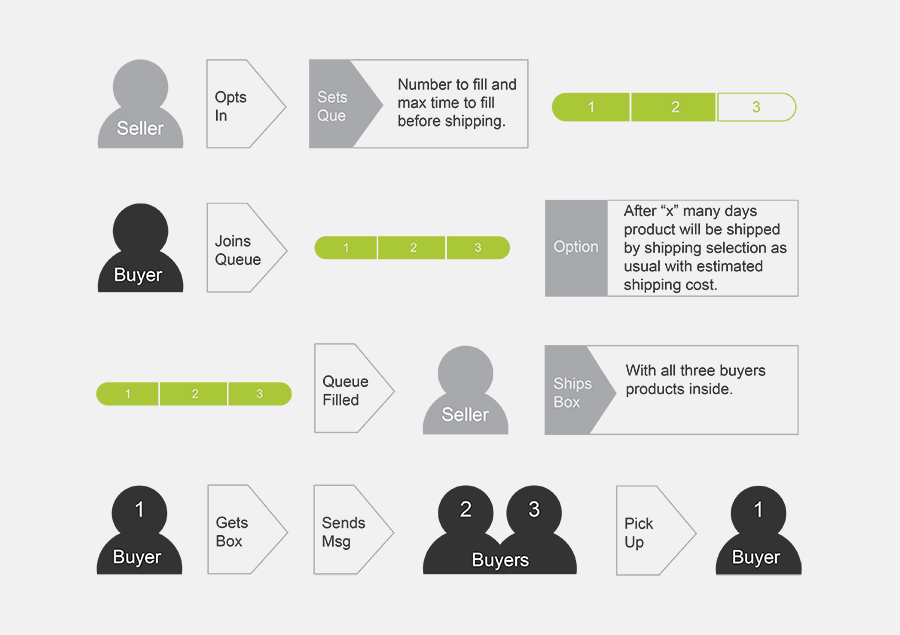
Best part: the package has 3-5 times as much stuff in it — making for three less packages, less packaging, and potentially less shipping cost to all buyers.
Meet In Person
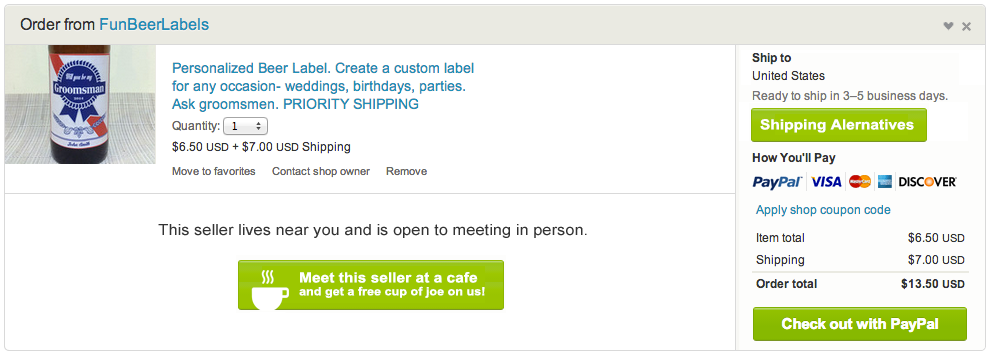
This is the final prototype and one that Matt was excited to talk to me about. I am thinking that as of now it may be in the works and with that in mind, I will do my best to do it justice.
Using the buyer and seller location to identify when they live close could provide a link to the solution as shown above. A message would be sent to the seller that a buyer is open to meeting in person. For the seller this engagement can lead to social capital and meeting valuable customer. Or even another seller that’s buying, since a high percentage of Etsy seller are also buyers this could be an opportunity to gell more as a community of makers and encourage collaborations. You never know when you might need something reupholstered or screen printed…
Etsy could also partner with a coffee shops in select cities to offer discounts for sellers and buyers meeting in person, and all this would be completely aligned with their mission!
The buyer saves the entire cost of shipping and, as a bonus, meets the creator or one of creators. This solution provides both a complete reduction of carbon on the shipping and buyer side (that is other than the transportation to get to the coffee shop.) The only limitation is that it might be hard to scale in places that are not New York or San Francisco.
Here is another diagram I made to assist in explaining the Meet In Person interaction:
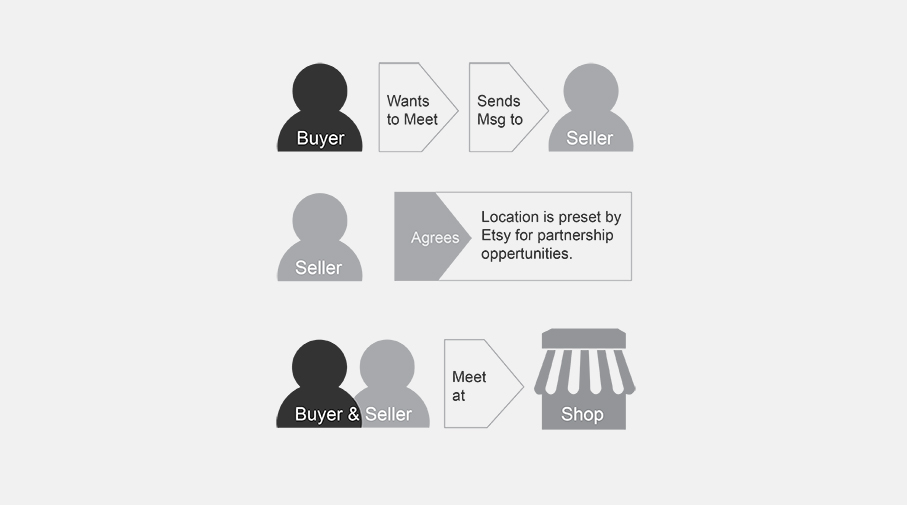
Conclusion
This has been a good grinding stone for me to sharpen my focus on carbon issues and shipping. As we continue to feel safer about buying things online the shipping cost will continue to increase in expense of both carbon and money. Solutions to help a digital commerce community deal with shipping are hard to create due to the limitations of processing the transaction of two strangers that could be possibly thousands of miles away. As Etsy continues with its mission I am excited to see how the platform sets the pace for the rest of the online commerce industry. I have no doubt after spending time there and speaking with Matt and Cap that they will. And they’ll do it well.